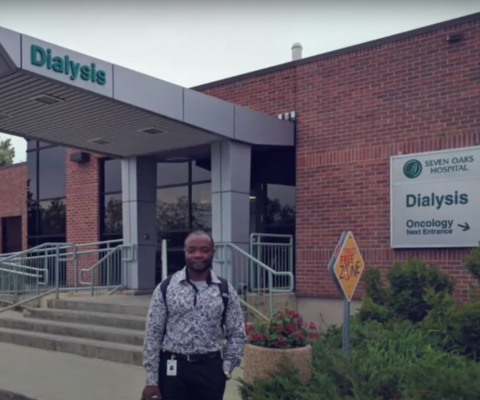Going places: The give and take of student mobility programs
Text on screen: [Going places: the give and tale of student mobility programs; Universities Canada logo; Foreign Affairs, Trade and Development Canada logo]
[Background music]
Narrator:
Higher learning. It’s a life-changing experience for students — whether they live in Canada or in a developing country.
But what if that learning could soar even higher?
What if higher learning could change not only the students themselves, but also their institutions, their surrounding communities and even their countries?
It can.
Because through international exchanges, internships and other mobility programs, postsecondary students are really going places.
Leah Erdos, intern, Acadia University:
“It didn’t change one thing, Ghana changed everything. It made me want to travel, it made me want to learn about people, that’s what’s important and that’s what matters to me. It’s actually about meeting the individuals and talking with them and having a relationship with them. It’s irreplaceable as an experience.”
Narrator:
Mobility programs are all about give and take.
When Canadian students go overseas, they share their knowledge, energy and enthusiasm with their host organizations.
When they return home to Canada, students bring back a whole new set of skills — the kind that more and more employers are looking for.
Qualities like leadership. Flexibility. Greater respect and tolerance for other cultures. And a willingness to get their hands dirty.
Paul Richard, instructor, Kwantlen Polytechnic University:
“Students love to be involved where they see the practical, immediate application. Whatever you learn in class, if you have a practical application it stays with you, you retain it.”
Narrator:
The hands-on experience can take many forms.
Teaching literacy. Fighting malnutrition. Working on advocacy and policy issues. Building up entrepreneurs and small businesses. And so much more.
Jacob Verhagen, intern, Acadia University:
“Now when I talk about things such as development and human rights, I’m not talking about something I learned from a text book or something I read, I can actually refer back to my experience when I was working in that field.”
Narrator:
For Canadian students, one of the big lessons is humility. Learning to accept what they can change, and what they can’t.
Arianne Lebel, intern, Université Laval in Senegal:
“Unlike in Quebec, here there are no rehabilitation programs for children with developmental delays. There are two-year-olds who can’t even sit up, problems like that. We can’t treat them here. We feed them as best we can and try to keep them alive.”
Narrator:
The learning never stops. Many Canadian students go overseas with big expectations of what knowledge they can share. But they soon discover their host organizations have much more to teach them.
Sister Madeleine, doctor, Saint-Martin Clinic, Senegal:
“In general I find that when they get here, they fit in quickly, they have team spirit and they show initiative. I often tell them that we benefit from their presence, that while they might be here to learn, we are learning from them, too.”
Narrator:
When Canadian students come home, they share what they’ve learned. They inspire others to learn more about the world around them, and Canada’s place in it.
The best kind of mobility programs include two-way exchanges. On the one hand, a Canadian student might work on a development project overseas. On the other, an international student might spend a term at a Canadian university to pursue research.
International students are also exposed to different values. This can help them in their studies, but it can also help change a world.
Sospeter Kamunilya, intern, Aga Khan University, Tanzania at University of Alberta:
“As I have seen here, most of the students – mostly women – are really empowered. Equity is really visible. So I will be working with different stakeholders to make sure that girl children are empowered in order to get education to the fullest. Because educating the girls is educating the nation.”
Narrator:
Sustainable change. It can start with the small step of sending post-secondary students to learn in another country.
They leave with their skills, their hopes and their dreams and they return with fresh perspectives, greater clarity about their careers, and a better sense of how to make their community, and their world, a better place.
[Background music]
Text on screen: [This project is funded by the Government of Canada through Foreign Affairs, Trade and Development Canada (DFATD); logo of Foreign Affairs, Trade and Development Canada]
Text on screen: [Logos of Universities Canada and Foreign Affairs, Trade and Development Canada]
Text on screen: [Credits: Thank you to the following universities for contributing video clips for this production:
Acadia University
Kwantlen Polytechnic University
Université Laval
Univesity of Alberta
Thank you also to Students for Development interns for contributing their photos.]
Through international exchanges, internships and other mobility programs, postsecondary students are really going places. Video on the former Students for Development Program.



